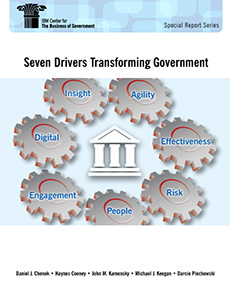
Drivers transforming government: Engagement

Note: The IBM Center recently released Seven Drivers Transforming Government, a series of essays exploring key drivers of change in government. It is based on our research and numerous insights shared by current and former government officials. This blog is the sixth in a series of excerpts from each of the seven essays. (Read our previous post on People)
Citizens increasingly look for new opportunities to engage with governments on how to approach problems, develop policies and programs, receive services, and create collaborative online and in-person relationships. Digital services, cognitive solutions, and open approaches to technology and data can open channels that bring citizens and governments closer together. This fosters a “citizen-driven” government based on real-time, multi-party communications to develop programs, as well as personalized transactions in receiving services.
Transforming How Government Engages
How Americans interact with businesses, news, entertainment, and other services has radically raised expectations for how they interact with government. Citizens expect the same level of service from government as they receive in the private sector, such as increased transparency, new ways to approach problems, and more personalized interactions. This includes:
- Harnessing the internet and social media platforms to engage in dialogue, co-create, and ultimately improve services.
- Establishing offices dedicated to exploring and leveraging innovation. For example, the U.S. Department of Veterans Affairs Center for Innovation has worked to identify, test, and evaluate new approaches to meet the current and future needs of veterans.
- Creating innovation labs as an opportunity for stakeholders across industries and disciplines to collaborate in solving complex challenges.
- Establishing digital services teams, such as the USDS and the GSA’s 18F, to help federal agencies develop new ways to engage and deliver services to citizens.
Expanding Citizen Engagement
Collaboration and co-creation can expand citizen engagement. Many examples at various levels of government show citizens engaging with public organizations to improve the front-end experience as well as the governing process. For example:
- Citizens can help identify important issues via crowdsourcing and co-creation platforms such as SeeClickFix, a mobile application where people report non-emergency issues in their cities which has led to fixing more than 3 million issues.
- Citizens can play a direct role in developing solutions to those issues through online contests and competitions, mobile apps, e-petitions, innovation jams, virtual design and prototyping tools, open-source databases, participatory design workshops, and online citizen communities.
- Experts in and out of government can work together in solving complex issues and enhance government services. For example, IRS’s Volunteer Income Tax Assistance program recruits accounting students, who receive training from the IRS, to assist low-income citizens with preparing their tax returns for free. During the 2015 tax season, more than 90,000 volunteers helped to prepare 3.7 million tax returns.
Leveraging New Capabilities and Technology
Advances in technology like cognitive computing and blockchain can drive a new and better citizen experience. These technologies increase citizen interaction on digital channels, providing additional personalization for users while freeing up resources for agencies to tackle more complex problems. For example, the U.S. Citizenship and Immigration Services’ cognitive virtual assistant, Emma, answers nearly 500,000 visitor inquiries every month. This allows agency staff to focus on more challenging cases and increases customer satisfaction across the board.
Scaling Innovation to Enhance Citizen Engagement
Going forward, agencies face the challenge of how to scale innovation across the enterprise and how to leverage new ideas from unexpected sources. The groundwork laid thus far can provide insight into how government can scale efforts. For example, Challenge.gov, a central portal for federal prizes and competitions, has scaled to include more than 640 competitions, participants from every state, more than $220 million in awarded prizes, and participation from more than 80 agencies. Part of the effort to scale will also require buy-in from other agencies and lawmakers, helping them understand the value of a citizen-driven, engaged government.
Valuing Data and Metrics
Organizations can leverage massive amounts of available data to better meet citizen needs. Data can help identify opportunities for improvement, inform design, and measure results. For example, the U.S. Department of Justice used data to create more objective techniques in their grant process, allowing them to review grants more frequently and in much less time. The open data movement and Data.gov have been instrumental in increasing transparency and collaboration to engage agencies, individuals, and the private sector.
Conclusion
There is a clear trend toward increased engagement of customers. With citizens increasingly getting this experience from the private sector, there is a growing gap between what citizens are expecting and getting from government. To close this gap, agencies must look to transform the design of services, the model for allocation of resources, and measurement and accountability models. Moreover, government leaders must integrate user experience to guide all citizen interactions. Engagement comes from more than simply making a mobile app or updating a website. It emerges from meeting the user needs in how they wish to interact with government.



